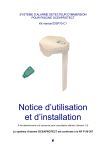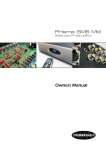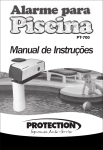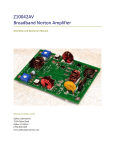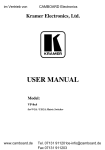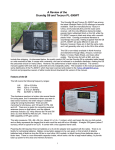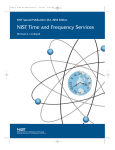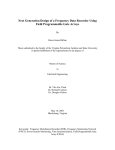Download Eton E1 Dark silver
Transcript
The Eton E1 Story © Bjarne Mjelde, Sept 2006 www.kongsfjord.no There is a classic TV commercial series on Norwegian Television. It ends with the phrase (translated from Norwegian): "Gotta have it. Just gotta have it!" I've been down that road with the Eton E1. Though resisting fiercely, when acclaimed MW DX-er Jan Alvestad said he had bought one and it performed well in his environment, I succumbed to the phrase above. I bought a refurbished set from Siegler in the USA, now out of business. The following will start off with a brief description and evaluation of the user interface and the different functions found on the Eton E1. I will then delve further into subjects of special interest to a "hard-core" DX-er like me, most notably sensitivity, selectivity and strong signal handling. And the Eton E1 story has a relatively happy end. The E1's display is very large and has room for all the information you need, including a large frequency readout. The illumination has three positions; off, dim and bright, and the contrast can be adjusted. Unfortunately, the "bright" position is nowhere as bright as I would want it, accustomed as I am with the IC-746Pro's exceptional display. May be difficult to read in dim light, or if the light source is behind the radio. Tuning is done by way of a tuning knob, up/down buttons, and direct input via keypad. The tuning knob could use a dimple to make quick tuning easier. Otherwise, one can choose to tune in 10, 100 or 1000 Hz increments. The up/down buttons are used for tuning in pre-selected tuning steps; 5 kHz on Shortwave and Longwave, and selectable 9/10 kHz on Mediumwave. The functions are easy to learn and easy to use. According to the specifications, frequency stability is +/- 10 ppm in the 0-50C temperature range. Not impressive. Actually it is advisable to let it warm up for an hour before doing much ECSS DX. In fact it seems that many (most?) E1s are supplied with an off-reading of 50 Hz or more. It is easy to align but it really shouldn't be necessary. Modes and bandwidth are chosen from a row with "soft buttons". One button defines the bandwidths as you cycle through the alternatives. One button defines AM/AM-sync, and one SSB button defines USB or LSB. If AM-S is selected, the SSB button defines USB, LSB or DSB (double sideband). There is no choice for modes like CW and RTTY. The button for PBT turns it on and off, and a separate control under the tuning knob adjusts the offset. The offset is displayed above the soft button. These functions are intuitive and easy to use. AGC is selected from a soft button which cycles through "Fast" (0.3 sec), "Slow (3 sec) and "Auto" (Fast during tuning, Slow when set to a frequency). I use Slow AGC most of the time. The release time seems to be very well chosen. Audio: Volume, Treble, Bass and Squelch controls are placed on the left side. The Treble and Bass controls do not have a very wide span, although they appear to be adequate for adjusting the audio blend to one's personal preference. I was not impressed though. Time, Memory: The E1 has rather advanced clock and timer functions which I will not delve further into now. One clock is displayed, unfortunately only hh:mm, not seconds. The E1 also has ample space for memory channels; 500 free to use and 1200 restricted to 120 countries. The memory channels are easy to store, edit and delete. They store frequency, mode, bandwidth, AGC setting, PBT setting and Sync detector setting. The External Antenna input is placed on the left side, with separate sliders for AM and FM to choose between internal and external antennas. The E1 does not have an inboard ferrite antenna, which has caused outcry among some users. Instead the whip is supposed to be used for MW reception as well as SW reception. Many have also commented the lack of a carrying handle. No problem for me, and the rubberised surface it has actually makes it very safe to hold. The 77-page manual is for the most part well written. It also contains a quite detailed specification list, and a block diagram. The appendix has an entry-level introduction to SW listening which could have been better, and obviously not made with the E1 in mind so maybe they borrowed the text from somewhere else. Sensitivity The first thing I usually do when I get a new radio, is to measure its sensitivity. To date I do not recall having seen sensitivity figures on the E1, except Eton's own specifications (Less than 2.0uV for the whole tuning range in AM, 1000 Hz, 30% mod but bandwidth not stated. 7 kHz?) So I pulled out my signal generator and AC voltmeter and started measuring. I was stunned. From deep in the LW band right through MW the AM sensitivity was -112 to -115dBm, mostly around -114 so in fact better than 0.5uV! Could the signal generator results be duplicated in real life? Well almost. I tested the E1 and a 746Pro on the Australian 4KZ-1620 which was a threshold levels at the time. Audio recovery in the 0.6uV 746Pro was marginally better than the E1. But the margin was very narrow indeed. Modes, AM Synchronous Detection In addition to the usual modes AM and SSB (which can be used for ECSS), the E1 is equipped with a selectable-sideband AM synchronous detector (AMSD). The ECSS technique is supposedly wellknown among DX-ers so I will not go into that subject here except note that the E1's ECSS reception is very good, once the frequency alignment has been done. So what does AMSD do? Some say that AMSD is the life and soul of a receiver - hinting perhaps that a non-AMSD receiver is no good. Baloney. For further enlightenment on the possible virtues of AMSD, please read Dallas Lankford's articles on the subject. AMSD is often associated with reducing distortion caused by selective fading. This is true, but you don't really need an AMSD for that; you can use an Elliptic Low Pass Audio Filter (ELPAF) instead. Selectable-sideband AMSD can also be used for reducing interference from one side much the same way as with ECSS. In general, AMSD has one downside compared to ordinary AM: It is usually non-transparent; it needs to lock onto a signal. This takes time, and is often accompanied with growling when the radio tries to center on the passband. Some AMSDs loose lock fast, some stay put. The E1's AMSD has three positions; USB, LSB and DSB (double sideband). I tested its distortionreducing capabilities on some fading SW frequencies. Reducing distortion will normally be best when using the sidebands, but I found that the AMSD was very effective even in DSB. On MW there wasn't much difference on the signals I tested, but if I had tested with groundwave/skywave blends I believe I might have had the same results as on SW. Comparisons were made with the AM Slow AGC setting. The conclusion is that if I want to listen to a SW broadcast I will probably use AMSD. And locking to a signal is rather straightforward. It does so within half a second, without muting the receiver's audio, and without growling. Or mostly without growling. If the carrier is far away from the radio's frequency it needs to tune in and does so much more slowly than the SE-3, and it growls a lot. But what about split-channel DX and interfering stations with very high signal levels? Well there's a mixed bag. I tested this specifically on 1250 (Ontario) with a strong European on 1251. And now we're at the core of the problem. The manual says that the AMSD will lock on the strongest signal in the passband. So even if you choose LSB, adjust the PBT to get away from 1251, and even if you manage to lock on 1250 - if 1251 increases its signal level it will simply take over the lock and you will find yourself listening to 1251 instead of 1250! The problem will of course diminish the further you are away from the offending signal. But there is in fact a problem here. Imagine this happening when you are waiting for an ID, 10 seconds before the full hour. I cannot recommend the use of selectable-sideband AMSD for serious DX unless you are certain that the lock won't be lost and "transferred" as it were, to the interfering station. This is especially true if you operate several receivers and need to let the E1 record audio unattended. On the other hand, if you meet that requirement, the audio quality from the selectable-sideband AMSD is very good. ECSS audio quality is good, better than expected. There are slight tonal differences between USB and LSB but they are not disturbing in any way. But the difference should have been avoided. Selectivity, Noise Reduction Portable receivers usually lack many (or all) of the interference-fighting tools. Alas, that is mostly the case with the E1 as well. As stated earlier, its ECSS tuning is very good, but ECSS must be regarded as a rather compulsory part of an HF receiver today. AM Synchronous Detection is quite good overall, but not suited for DX-ing narrow splits. So, what do we have? IF Filters According to Eton's specs, there are three bandwidth choices; 2.3 (sometimes referred to as 2.5), 4.0 and 7.0 kHz. The 2.3 is apparently the muRata CFJ455K5 which is mounted in a large number of receivers. I don't know the origin of the other filters. Judging from audio recovery, I'd say the 4.0 is more like 4.5, and the 7 is more 8-ish. I hope someone will take the time to measure the correct bandwidths and the shape factor. They appear to have good ultimate selectivity though. There's nothing wrong with the filters except my personal preference would probably be less than 4, and 6 kHz for the two wider filters. Other people with other preferences will surely disagree. Actually, a portable with a choice of three mode-independent, good quality IF filters must ble close to one of a kind. Passband Tuning (PBT) Something we cannot do without! The PBT can be tuned +/- 2 kHz. For reasons mentioned below, the PBT is in more use on the E1 than on my other receivers. A Notch Filter is an essential tool for removing heterodynes. Any notch filter will do really, even a basic audio notch filter - but the E1 has none. That is in fact a major drawback with the radio. Removing or reducing hets can to some extent be done by using the PBT, but it is 1) time consuming and 2) can result in increased interference from a different source. A Noise Blanker is also missing. Ignition-type noise, and in my case Loran C ticking, can be reduced with a good noise blanker. And there is no Noise Reduction function. Although we have seen many of questionable quality, and that they often degrade the audio quality, in some instances they really do help. Obviously, here's where the tabletop and the portable go separate ways. Strong signal handling With a sensitivity at the 0.5uV level, the E1 needs to have a good front-end, especially when connected to large outdoor antennas. According to the block diagram in the user manual, the radio incorporates bandpass filters at 1, 2, 4, 8, 16 and 30 MHz. The preamp (or "DX" setting) is 10dB according to the block diagram. According to specifications, IP3 at 5 kHz spacing, preamp on, isn't really out of this world: -30dBm. It should work well in a "normal" RF environment (whatever a "normal" RF environment is). What about mine? My RF environment is surely not normal. It consists mainly of a Loran C transmitter on 100 kHz, 14 km away as the crow flies, and the output is 250kW. I also have an NDB, BV on 399 kHz, 16 km in the same direction. My North American beverages point more or less directly towards them. I have an array of five beverages, at present connected to an antenna selector, via a switchable 1013dB push-pull Norton preamp, into an amplified 1:8 splitter where the preamp is identical to the first but has a net gain of 5 dB. It is also switchable. Normally I use the splitter preamp all the time, and turn on the other preamp when signal levels drop after sunrise or before sunset. I use the receivers' preamps as I find necessary. But after sunrise, they are indeed needed. So what's the E1 front-end like? The Loran C should be a good indicator if the receiver is prone to overload. When both external preamps are engaged, there is a bit more Loran C noise below 1 MHz than I find on the other receivers. Nothing dramatic though. However, if I engage the "DX" setting, the Loran C will take over the AGC completely and mute the receiver. But - only below 1 MHz. The front end filters are doing their job. If I disengage one of them (no matter which), the overload disappears. I also did a test on the 49-meter band at late evening when signal levels are very high. I used an amplified ALA100 8x4m loop, If I engaged all preamps, there was severe intermod. If I disengaged one of them (no matter which) the intermod disappeared. Mind you that none of the other receivers behaved the way the E1 did. Conclusion: The Eton E1 is not bullet-proof. Use the internal preamp only when it is really necessary, especially if you have a very strong RF source within the passpand. I feel rather lucky that Eton chose to put the first bandpass filter at 1 MHz and not at 1.8 or 2. That would have limited the E1's capability as a MW DX receiver. However, with the preamp disengaged MW sensitivity will still be close to 1uV. A little disappointment this, but it doesn't really spoil my impression of the E1. I keep comparing it to receivers/transceivers costing at least three times as much and it is doing remarkably well. Conclusion: The Eton E1 is a portable with the ambition to perform equal to a high quality tabletop. With a few exceptions it really does act like a tabletop, but while getting there it has lost some of the characteristics of a portable. Nevertheless, the Eton E1 is an excellent receiver in its own right and will perform admirably in most challenging DX situations. And the price simply cannot be beat.




